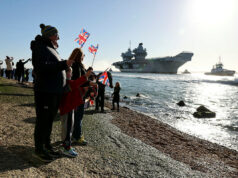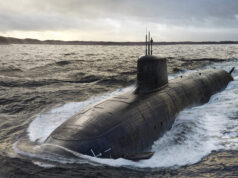HMS Forth, the first of five new Offshore Patrol Vessels being built on the Clyde, has departed Glasgow on sea trials today.
HMS Forth is the first of a new class of River class offshore patrol vessel under-construction on the Clyde.
On the 6th of November 2013 it was announced that the Royal Navy had signed an Agreement in Principle to build a batch of three new OPVs based on the River class design at a fixed price of £348m including spares and support, an additional two Batch 2 vessels were outlined in the Strategic Defence & Security Review in 2015.
The First Sea Lord recently elaborated on the potential uses for the vessels, including the possibility of forward basing an extra ship at the Falklands Islands, or forward basing it elsewhere. Admiral Sir Philip Jones said:
“Well, you are absolutely right that they have proved enormously useful, flexible and reliable ships. There are four vessels that we have in service at the moment. Three are Tyne, Mersey and Severn, which operate largely in UK waters on fishery protection and offshore tapestry protection, and of course they are increasingly working with the Border Force and the Maritime and Coastguard Agency in support of protection of UK waters. Then we have a fourth one, which is permanently based in the South Atlantic.

We have had those ships in service for quite some time now. We are looking at replacing them with slightly larger and more capable ships in due course anyway, so that was already in the course of production to bring three of those in.
The additional two will enable us to take a longer term view of how we replace HMS Clyde, which is a slightly larger helicopter-capable version of the OPV. We are looking at a number of ways in which we might use the fifth one. So, the fourth one is clearly a Clyde replacement.
The fifth one can either be added into the mix for the three that operate in UK waters or it could be forward-deployed somewhere else in the world, or it could become a second vessel operating in the South Atlantic. All those options are available.”
Great to see #FORTH sailing from @BAES_Maritime on the Clyde on Sea Trials this afternoon #OPV Superb #OneTeam effort! pic.twitter.com/UTxdCw5HH0
— Geoff Searle (@Type26ProgDir) August 30, 2017
This comes amid a naval version of musical chairs with two Hunt class ship crews becoming the new ship’s company of HMS Tyne whose own sailors are to crew the new HMS Forth in order to bring the vessel into service.
According to the Royal Navy, under Project Jicara, two crews from Portsmouth’s 2nd Mine Countermeasures Squadron will join the Fishery Protection Squadron to man and operate one of the River-class vessels while their own Hunt class ships are out of action undergoing major engine changes.
HMS Tyne is a River class offshore patrol vessel built by Vosper Thornycroft in Southampton to serve as a fishery protection unit within UK waters along with her two sister ships Mersey and Severn.
Lt Alex Coleman, Executive Officer of MCM2 Crew 6 said:
“The opportunity to man and operate an offshore patrol vessel for a Hunt-class crew is quite unique.
This is a great chance for many of our sailors to broaden their skills on different machinery and shows just how adaptable and employable the guys really are.”
The crew will be in charge of HMS Tyne until the end of the year, when they’ll move to HMS Mersey, allowing the latter’s crew to move on-board new River class vessel HMS Trent.














Presence is a big part of RN duty, low level threat environment and deterrence.
It seems I am in the minority in thinking these B2s could really be part of the solution in relieving pressure on larger more important assets.
More T-26 & B2s, do it quick, drive economies of scale and forget the T31s.
You aren’t wrong Ian.
Thing is, these aren’t ideally suited for the ‘presence’ mission.
The Holland Class OPVs are what I would see as the best vessel of its type in the world.
The Netherlands use them for their territories in the Caribbean.
A true ocean goer and has a large enclosed hanger as well as a stern ramp for boats underneath the flight deck.
Better armed, better sensor package, better aviation, more accommodation & all for less money.
The presence ship that the Royal Navy should have gotten.
Those Holland class are impressive ships. Wikipedia is quoting the 2012 price as about $150m per ship which at pre-Brexit-referendum exchange rates would have been about £100m or slightly under that. Even adding a couple of years of inflation to account for the first River B2 order being placed later (I think) it’s still less than we paid for the new Rivers. I know there were TOBA issues but I really wish we had been able to get more for our money.
Still, we are where we are. Invest in containerised drones that can be embarked as necessary and maybe also a Sigma mount at the front to add LMM would be a way to at least maximise the investment already made for a fairly modest amount of extra money plus any drone developments would be of benefit to far more than just the Rivers.
Seems others agree with the Holland thinking Joe.
My Q is now we are committed to five of them, build a few more or?
I agree with the holland class thinking as “best in class”, but this doesn’t meant that these vessels are crap, it just means they are less than they could have been.
As such I believe Ian’s comments are valid.
I actually hate OPV’s and what they stand for in the modern RN (i.e.: cost reduction) but do accept that they have a valid role.
Yes, these ships will do the “donkey work” of patrolling UK waters undergoing fisheries protection work etc.
They will also have a much greater ocean going capability than the B1 rivers and as such will be able to undertake constabulary roles and flag waving visits to the Caribbean etc.
In addition the vessels can carry a much larger EMF than their predecessor ships.
They will be useful and hardworking additions to the fleet.
Is it made from Lego bricks and then covered with a polythene skin ? What an ugly looking vessel.
Good bow line ,flush deck, streamlined bridge. You looking at the same ship as me, Steve?
Maybe nothing wrong with the design but the quality of build ………
I agree what ugly looking vessels these river class ships are.
The River B2s are desperately needed to ensure presence, especially around UK shores post Brexit and the return of our EEZ.
As the River batch 1s are still less than 15 years old they need to be retained in either RN or border force service.
We simply need more vessels out there, ideally equipped with UAVs. They can relieve pressure on our frigate and destroyer fleet but do not make up for inadequate numbers. These vessels are not warships and would be a total liability and endanger their crew if placed in a threat environment.
Do the Rivers really make sense for UK EEZ work? Complement of about 30 vs 12 for a 42m Border Force cutter plus a bigger vessel will give much greater annual running costs. Capital budget alkso could buy much more with the purchase cost of the B2s of over £100m each vs probably well under £10m for a BF cutter (£4.3m each in 2004). In home waters multi-week endurance isn’t required, in fact it would make staff retention harder.
The new batch 2s, with some UAV capability (I agree with you there) would be appropriate for anti-piracy and anti-drug-running operations overseas where gunfire is much more likely to be exchanged but the B2s (or B1s) seem to me to be overkill for UK EEZ use. Also, no need for UK EEZ vessels to host drones – why couldn’t those be better and more conveniently launched, maintained and controlled from a ground base? I do also agree though that there should be much more drone use for EEZ surveillance just not launched off ships.
There’s enough work for the B2s outside the UK EEZ and if any sort of decent price could be got for the B1s I would say sell them and buy more 42m cutters rather than saddling the BF with such high staffing and running costs so no appreciable gain.
Would there be any benefit to scrap type 31 and order lots of top notch highly armed corvettes at 2-250 mill a piece?
Get lots of hulks that can credibly carry out many roles and be in lots of places at once, including peace time carrier protection.
Can the 42m cutters operate in foul weather? The River class are apparently excellent and tough sea boats able to operate in all weather conditions even mid Atlantic.
A very good question. That is my big concern about there being a possible big hole in my argument. I just don’t know the answer. I’ve been hoping that someone here with expert knowledge might comment. Excessively heavy weather would also hamper much smuggling and smaller fishing operations however but again I’m not sure how much validity that argument has either.
Could a variant of River 2 replace the Hunts or Sandowns?
https://www.atlas-elektronik.com/fileadmin/user_upload/documents/products/Mine_Warfare_Systems/ARCIMS_ModularUSV_System_online.pdf
I think I remember seeing somewhere that HMS Forth is manned by the crew of HMS Tyne, which is now crewed by sailors from Hunt class. A sign of things to come? Perhaps we should not be thinking of River 2 as a ‘failed OPV’ but more as a beefed up Hunt/Sandown cum Echo/Enterprise?